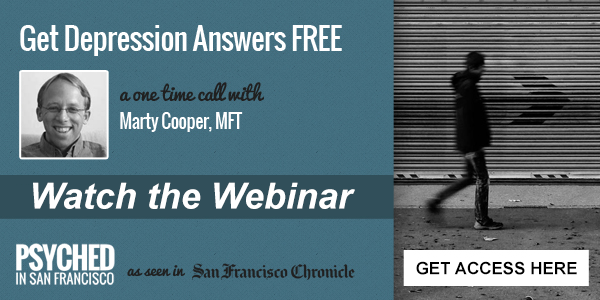Depression and the Art of Savoring
Richard, a diligent type-A tech guy, who defended against his depression with unending work, sat on my couch and listed what he had accomplished this last week. After that, with barely a pause, he launched into his tasks for, and worries about, the upcoming week. Given his pace, when I asked him which of the completed tasks brought him the most pleasure, it was as if, as the passenger in his car, I’d suddenly yanked the handbrake.
“Well…I’m glad they’re all done. It frees up energy to work on the next stuff.”
“Yes, got it. And what did you enjoy about them?”
He looked nonplussed and annoyed.
“OK, how about this: What in those accomplishments is there to savor?” I asked.
He just squinted at me in his “what are you trying to pull” face that we’d come to know well.
Ann was in the middle of a mid-grade depression. She described her days as gray, undifferentiated, dull. She could go to work and engage with family, but didn’t have much energy or interest. When I’d ask about enjoyment, she’d look away, and say, “Not much.” When encouraged to look at what was actually there, she’d eventually admit, “It’s just too painful to go there.”
It verges on the self-evident to say that depression sucks the joy out of life, but that indeed is what it does. But the reason for doing that is actually a good one, from depression’s perspective: Something in our life (could be a deceased friend, a philosophy of life, a dream or goal, etc.), which we’ve been attached to, is dead or dying, but though we can register that fact, it is proving intolerable to actually let go. Depression (as a sort of sub-routine in the computer of our mind) believes that to continue to chase after that lost thing will result, like an engine on perpetual high revs, in burnout. So since we are not able to hit the off switch, depression does it for us. It accomplishes this by making the world (and self) look and feel so un-enticing that we fall back from, not just that which is lost, but everything. If depression is essentially a safety mechanism, then it’s one that uses a scorched earth approach to keep us, in its view, secure.
Given that, a key requirement for healing from depression is the restoration of pleasure. However, because depression is so comprehensive in its numbing effect, we have to reclaim pleasure in a measured way, carefully, since to experience pleasure is to open to our experience, and that openness is just what depression doesn’t trust. “If I let you off the leash, you’ll go chasing that thing again, and then come to destruction.”
So, the practice is both in locating pleasure (what you’d do in developing a list of pleasant activities), but then there’s the challenge of “savoring.”
Savoring is defined as, “The giving of oneself to the enjoyment of” some experience. To savor a spoonful of spaghetti sauce is to give time and attention to experience the pleasure, the joy of the tastes. It’s not analyzing or judging or critiquing; it’s the act of allowing ourselves to open to the richness of an experience.
Back to Richard: what I was trying to do with him was slow him down so he could actually taste and therefore digest the good and pleasurable in his own life. His depression was kept at bay by busyness, but that survival strategy had the effect of stripping out the flavoring. There was plenty of “food”–he was very engaged, project-laden, and lauded for his accomplishments–but he felt threatened by the slowing down and focusing that is required to savor, to “give oneself to enjoyment of,” because in the past when he was forced to slow down (as when between jobs) he kept slipping into the pit of depression. So though I was encouraging an “enrichment” of life, what he initially heard was “cut the safety line.”
Ann, in contrast to Richard’s hyper-energized state, was plagued with “hypo-energy”: Her system couldn’t muster enough juice to use a type-A defense. But in this collapsed way, she also shared the tasteless quality of life, and the sense of threat when I asked about savoring. She was speaking to how pleasure is not just unavailable or unattainable when depressed, but in her “It’s too painful to go there,” how pleasure is guarded against.
The Practice of Savoring
Re-awaking to pleasure, and learning to savor is not all that dissimilar to healing from frostbite. You get out of the cold, to somewhere warm (like a therapy office), gently rewarm the frostbitten areas (the capacity to feel pleasure), and take pain meds (i.e., whatever is soothing to the nervous system). In other words, it needs to go slow. We’re exposing ourselves to small bit of pleasure, and staying with that experience of pleasure, to allow depression to see that enjoyment is not unsafe.
So the emphasis, especially if we are very depressed or very defended, is on small chunks. To expose either Richard or Ann to a deluge of sensation and pleasure (say, a week-long spa retreat) is going to send their systems into paralysis and then either despair, or running for the hills.
We have to go slow, trusting (and getting support from the trustworthy) that we indeed have to build back up to a capacity to feel safe in savoring our lives.
So for Richard, this meant working to help him (as a fairly intellectualized guy) to have a map of savoring and pleasure that included the reason why it was important (as an antidote to the “dryness” of his life), and then with that hard-won agreement on the terrain, doing exercises where he’d allow me to stop him, and hold open the space for him to feel. So as he was barreling along with reporting on his life, I’d stop him and note the pattern. “Yes, I know, but let me tell you one more thing,” at which I’d raise an eyebrow, and he’d smile. “Pick one thing,” I’d say, “whatever scale, which actually felt enjoyable.” He’d breathe–we’d worked on that as self-soothing–slow down, and then be able to notice that one thing. We’d then hold off distractions from that savoring, and focus attention just on the experience itself as he remembered in the moment, and he came to learn the experience of enjoyment, and how with support and self-soothing, he could safely slow and savor.
For Ann, the challenge of savoring started also with getting her left, analytic brain to buy in. So we talked about the need to reclaim pleasure, and the need to respect depression, in its protector role, by acknowledging that she had to control the pace, and that had to be slow and careful to not trigger more depression. So we used the here and now of the office. One of my paintings had a house in it that reminded her, in a pleasurable way, of a childhood home. So we worked to savor just that experience, and when the “Can’t be safe” or “What’s the point” voices came up, were able over time to bracket them off, making room for enjoying more of that experience. As it became clear to her (to her guards, really) that the pleasure was not dangerous, then there was more of the world around her that opened up to pleasure.
An Exercise in Savoring
There is much to say about healing from depression, but the work around pleasure and savoring is a substantial component of that process. So here’s a savoring exercise for you to try and modify as you like. (If you’re experiencing depression, go slow, or even do this with your therapist.)
1) Get into a comfortable physical position.
2) Ask yourself, “What today did I experience that was enjoyable.” (If nothing comes to mind as you scan your memory, look around your immediate surroundings, and see what stands out to you as a visual pleasure. You don’t have to make it pleasurable; look for whatever, when you land your attention on it, brings a zing of pleasure. Doesn’t matter why.)
3) Focus in on the memory, or object, and see how you are experiencing the pleasure. Is it more emotional, physical, intellectual? How strong? How “rich”? I.e., whatever is in the experience that you can describe as pleasurable?
4) Savor it. Meaning: spend time with the experience of pleasure, keeping your attention with the pleasurable experience. (Most often, even if you didn’t notice it initially, you’ll find the root of the pleasure in body experience),
5) See how long you can stay with it, how long the “savoring session” goes. You might find it stretches out longer than you thought. You might find it gets short-circuited by some distraction, or some invalidation of the pleasure (e.g., “Who are you to stop working!?”). Or it might run its course, and you come back to a neutral position of experience, the “flavor” having been fully experienced.
Pleasure and enjoyment are incredibly powerful healing and transformation agents. Notice how the whole exercise goes–what its results are, what changes–in order to inform this practice of savoring, and develop a trust in pleasure. Enjoy!



